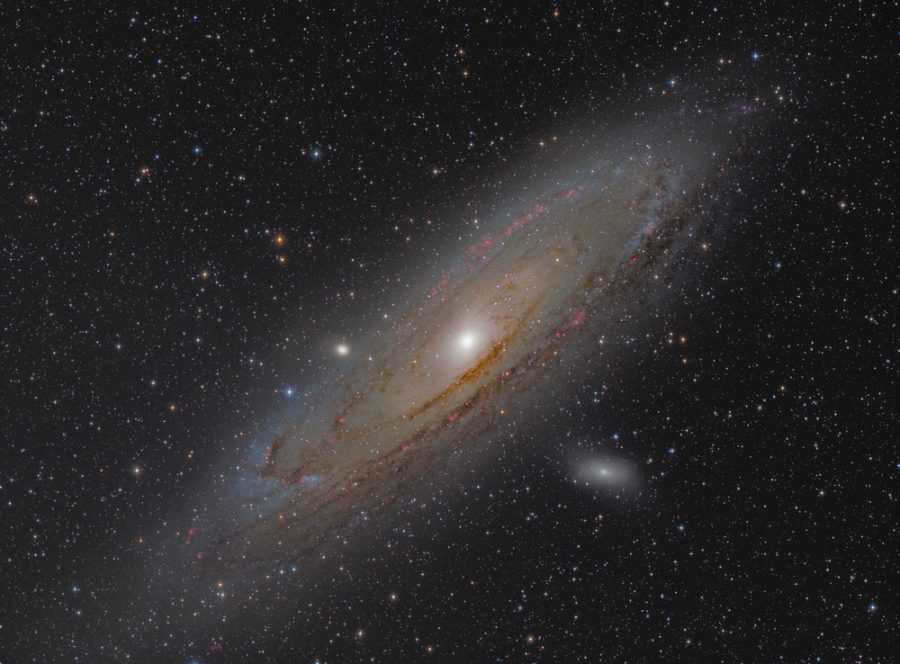Seismic events, similar to earthquakes, can also occur on stars. However, these events are not visible to us in their entirety due to their distance. Nevertheless, we can make an estimation based on the fluctuations in the brightness of the star. By studying the propagation of elastic waves within a star, we can gain knowledge about its composition and age. This information can also be used to estimate the age of a galaxy.
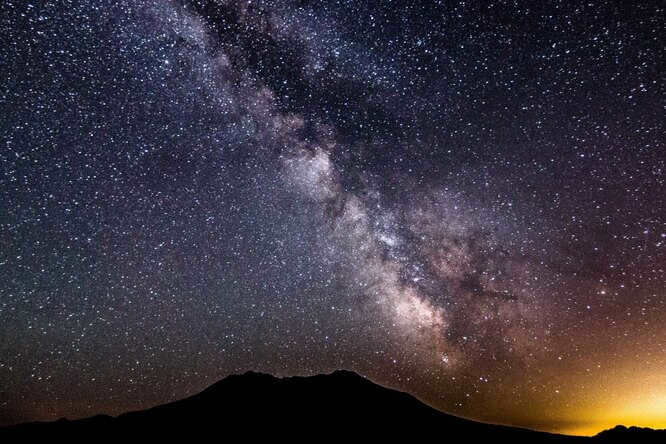
The Milky Way, our home galaxy, has been in existence for billions of years. It formed long before life appeared on Earth, around 4.5 billion years ago. Scientists have used various methods to determine the age of the Milky Way, including the study of astroseismology.
During the latter phase of its mission, the Kepler space telescope provided valuable insights into this inquiry. Originally intended for the detection of exoplanets through the transit method – the observation of variations in a star’s brightness as a planet moves across its path – this remarkable instrument possessed optics of such sensitivity that it could detect the movement of a flea on a illuminated car headlamp. Paradoxically, it was this very device that played a crucial role in determining the age of our own Milky Way galaxy.
Discovering the Age of Our Galaxy: A Scientific Breakthrough
Scientists have made a groundbreaking discovery regarding the age of our galaxy, the Milky Way. Like many other spiral galaxies, it is composed of two distinct parts: a thick outer disk and a thin inner disk. The thick disk, which comprises approximately 20% of the stars, is believed to be slightly older than the thin disk. However, determining the exact age difference between these two components has been a subject of intense debate within the astronomical community, with estimations varying by billions of years. The question remains: how can we accurately calculate the age of the Milky Way?
The “sounds” of stars may not be audible, but they can be observed through a thorough examination of the data compiled by the Kepler mission over the course of several years. It is important to recognize that stars are relatively uncomplicated entities, therefore even a limited amount of knowledge about the transmission of elastic waves within them can provide valuable insights into their chemical composition, and subsequently their age.
What is the age of our galaxy?
By studying the ratio of iron to hydrogen, scientists have been able to make a relatively accurate estimation of the age of our galaxy. The findings suggest that the average age of stars in the thick disk is around 10 billion years. This means that the stars in our galaxy are incredibly old. Therefore, we can conclude that our galaxy itself is also very old. While scientists have been able to determine the age of our galaxy, the age of the black hole in the Milky Way still remains unknown.
For more information, you can read the full article published in Monthly Notices of the Royal Astronomical Society.
TechInsider Online Edition
Founder of Fashion Press LLC: 119435, Moscow, Bolshoi Savvinsky per. 12, str. 6, floor 3, room II;
Address of the editorial office: 119435, Moscow, Bolshoi Savvinsky per. 12, p. 6, str. 6, floor 3, room II;
Editor-in-Chief: Nikita Vasilenok
Email address of the editorial office: [email protected]
Phone number of the editorial office: +7 (495) 252-09-99
Information product label: 16+
The online edition is registered by the Federal Service for Supervision in the Sphere of Communications, Information Technologies and Mass Media, registration number and date of registration decision: series EL No. FS 77 – 84123 dated November 09, 2022.
© 2007 – 2023 “Fashion Press” Ltd.
By posting content on the Website, the User gives “Fashion Press” LLC the right to use, reproduce, distribute, create derivative works, and display the content, as well as make it freely available to the public.
Our galaxy, the Milky Way, is just one of countless others. Despite this, it is still filled with numerous enigmas. Here are several intriguing tidbits about our cosmic home that you might not be aware of.
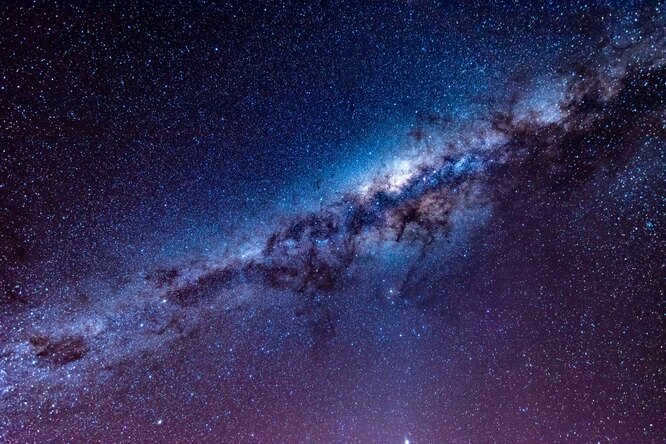
There are numerous enigmas within the Milky Way that have yet to be solved. However, you may not be aware of them.
The Form and Size of the Milky Way
The Milky Way is a spiral galaxy that spans approximately 100,000 light years. Recent advancements in telescopes have allowed astronomers to identify the fundamental shape and structure of nearby galaxies, even before they were recognized as such.
Nevertheless, the process of reconstructing the shape and structure of our own galactic abode has been a sluggish and painstaking endeavor. Scientists have had to meticulously document stars, chart their positions in the sky, and ascertain their distance from Earth. Gradually, astronomers have pieced together a detailed portrait of the spiral galaxy, which now appears rather ordinary.
The Position of the Sun within the Milky Way
The Sun plays a crucial role in sustaining life on Earth, providing us with light and heat. However, when considering the vastness of the galaxy, the Sun is just one of many stars, and it is rather unremarkable. Positioned approximately 26,000 light-years away from the Sagittarius A* black hole, the Sun resides in the central region of the galactic disk. It travels at a speed of 828,000 km/h, completing a full orbit around the galactic center every 230 million years. This means that the last time our planet occupied its current location in the galaxy, dinosaurs walked the Earth.
The Sun is located on the outer edge of the Orion Arm, which is one of the smaller spiral arms of the Milky Way galaxy. Astronomers discovered in 2019, through the analysis of data from the Gaia mission, that the Sun follows a wave-like motion within interstellar gas. This wave spans a distance of 9,000 light-years in length and 400 light-years in width, while oscillating 500 light-years above and below the galactic disk’s plane.
What is the age of the Milky Way?
The age of the Milky Way can be traced back to the formation of the first stars from collapsing clouds of gas and dust. These stars, which can still be found in globular clusters today, marked the beginning of the galaxy’s evolution. Over time, a spherical halo and a flat galactic disk formed, and the Milky Way grew larger as material was drawn in by gravity. Despite ongoing research in the field of galactic archaeology and the valuable data provided by the Gaia mission, the exact age of our galaxy remains unknown. However, continued analysis of the available information holds the potential to uncover new insights and provide a clearer understanding of this age-old question.
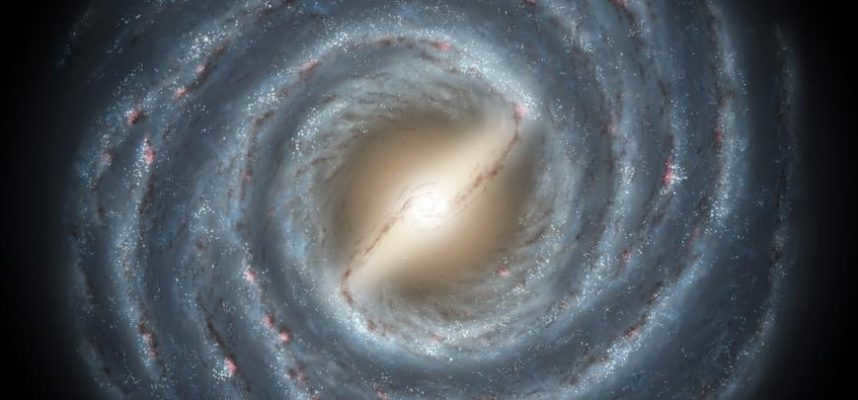
Many galaxies are estimated to have formed during the early stages of the Universe, when it was around 10 to 13.6 billion years old. This suggests that most galaxies are several billion years old.
The age of our Milky Way galaxy is thought to be approximately 13.6 billion years, making it one of the older galaxies in the Universe. However, there is evidence of a newer galaxy that emerged relatively recently, around 500 million years ago.
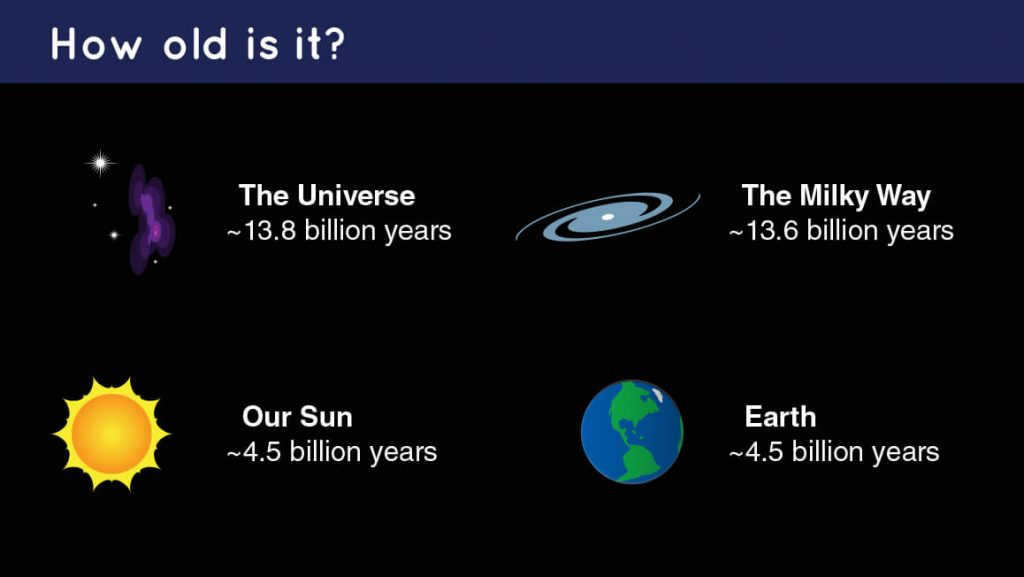
The age of the universe is estimated to be around 13.8 billion years, while the Milky Way galaxy is thought to be slightly younger at 13.6 billion years. Our own Sun is approximately 4.5 billion years old, and the Earth is also believed to have formed around the same time.
How do astronomers study objects that are located at such vast distances?
Astronomers rely on the use of light to study objects that are located far away in space. In fact, studying light can even provide us with a way to observe events that occurred in the past!
Light always travels at a constant speed, which is nearly 300,000 kilometers per second. This means that light can cover a distance of about 10 trillion kilometers in the span of one Earth year. Astronomers refer to this distance as a “light year.”
As a result, the farther an object is from us, the longer it takes for the light emitted by that object to reach our observation point.
What is the most distant galaxy we are aware of?
During the year 2016, scientists employed NASA’s Hubble Space Telescope to examine a galaxy known as GN-z11, which resides at a distance of 13.4 billion light-years. Due to its immense distance, Hubble is able to perceive the light emitted by this youthful galaxy as it appeared when the universe was a mere 400 million years old.
This video displays the position of the most distant galaxy ever observed, known as GN-z11. The credit for this animation goes to NASA, ESA, and the following individuals: P. Oesch from Yale University, J. Brammer from STScI, P. Van Dokkum from Yale University, and G. Illingworth from the University of California, Santa Cruz.
Astronomers have conducted observations of numerous galaxies at various distances. Through the process of comparing these galaxies, we can commence to comprehend the origins of galaxies and their stars, as well as their evolution and eventual demise.
Just a few centuries ago, astronomers maintained the belief that the Milky Way constituted the entirety of the Universe and that there was nothing beyond it. However, with the advent of more advanced telescopes, it became feasible to provide evidence for the existence of other galaxies.
The Milky Way Galaxy
The Milky Way is a spiral galaxy that spans 100,000 light years and includes our solar system.
If you find yourself in a location far from city lights, where the night sky is pitch black and the stars shine brightly, you may catch a glimpse of a faint band of light. This band is made up of millions of tiny, luminous points and radiant glimmers. Before your eyes, you can witness the stars that make up the Milky Way.
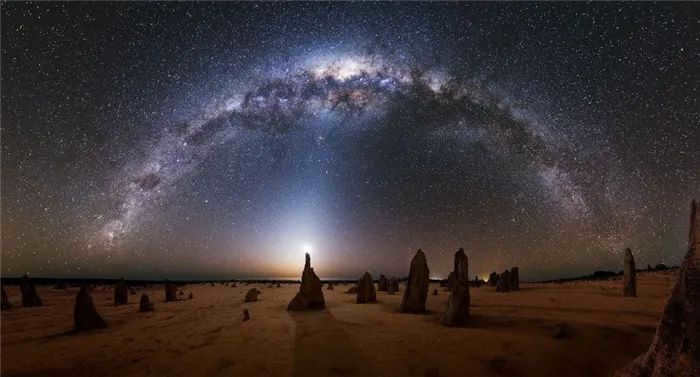
However, what exactly are these galaxies? In the first place, the Milky Way is categorized as a spiral galaxy that houses the solar system. It’s quite a challenge to label our galaxy as one-of-a-kind since there exist countless galaxies in the vast expanse of the universe, with numerous of them bearing resemblance to one another.
- Following the Big Bang, the formation of the Milky Way commenced as a collection of concentrated regions. The initial stars emerged within globular clusters, which still persist today, making them the most ancient stars in the galaxy;
- By incorporating and merging with other galaxies, the Milky Way has expanded its parameters. Currently, it is assimilating stars from the Sagittarius Dwarf Galaxy and the Magellanic Clouds;
- The Milky Way is in motion through space, accelerating at a rate of 550 kilometers per second relative to relic radiation;
- At the center of the galaxy lies Sagittarius A*, an immensely massive black hole, with a mass 4.3 million times that of the Sun;
- Gas, dust, and stars orbit the galactic center at a speed of 220 km/s, maintaining a steady pace that implies the presence of a dark matter shell.
- In approximately 5 billion years, the Andromeda galaxy is projected to collide with the Milky Way. There are theories suggesting that the Milky Way is a binary system with a massive spiral;
The Milky Way possesses a fascinating name due to its mist resembling a galactic path. Its name has ancient origins and is derived from the Latin term “Via Lactea”. This name can already be found in Nasir al-Din Tusi’s Tadhir, where he describes it as “made up of numerous small stars tightly clustered together, appearing like spots. Its hue resembles that of milk…”. Take a look at an illustration of the Milky Way, featuring its arms and center (even though capturing an actual photograph of the Milky Way is not yet possible, there are comparable structures and accurate data regarding its composition, allowing us to form a conceptual image of the galaxy’s appearance).
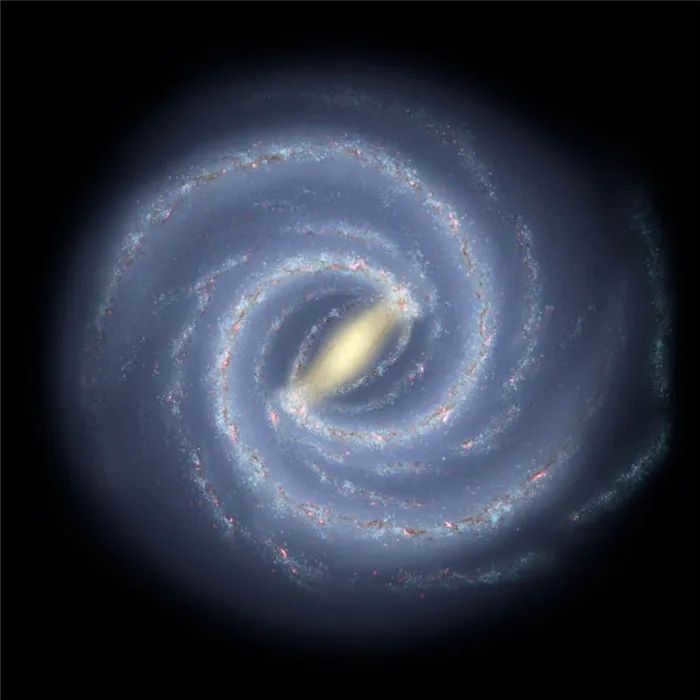
An artistic depiction of the Milky Way as observed from the vantage point above the northern pole.
Until the year 1610, scientists held the belief that the Milky Way was teeming with stars. However, this hypothesis remained unverified until Galileo Galilei turned his inaugural telescope towards the heavens and beheld individual stars. This groundbreaking observation unveiled a new truth to humanity: the abundance of stars in the Milky Way far surpasses our previous estimations.
Back in 1755, Immanuel Kant held the belief that the Milky Way is a gathering of stars that are held together by a common force of gravity. This gravitational force causes the objects to rotate and take on a flattened, disk-like shape. In 1785, William Herschel attempted to determine the shape of the galaxy, but he was unaware that a significant portion of it was concealed behind a haze composed of dust and gas.
Fast forward to the 1920s, and the situation had changed. Edwin Hubble successfully convinced us that what we were observing were actually individual galaxies, rather than spiral nebulae. It was only then that we were able to discern the shape of our own galaxy. It has since become evident that the Milky Way is a spiral galaxy with a supermassive spiral at its core. In this video, you will gain a deeper understanding of the structure of the Milky Way, including its globular clusters and the vast number of stars that call the galaxy home.
The Milky Way can be easily identified in the night sky by its wide, elongated white streak resembling spilled milk. Remarkably, astronomers have been studying this stellar cluster since the early days of planet formation. In fact, this region serves as the hub of our galaxy.
Spanning an impressive 100,000 light-years in diameter, the Milky Way showcases a distinctive bulge at its core, from which four grand spiral arms radiate outward. This particular structure accounts for two-thirds of all galaxies in the cosmos.
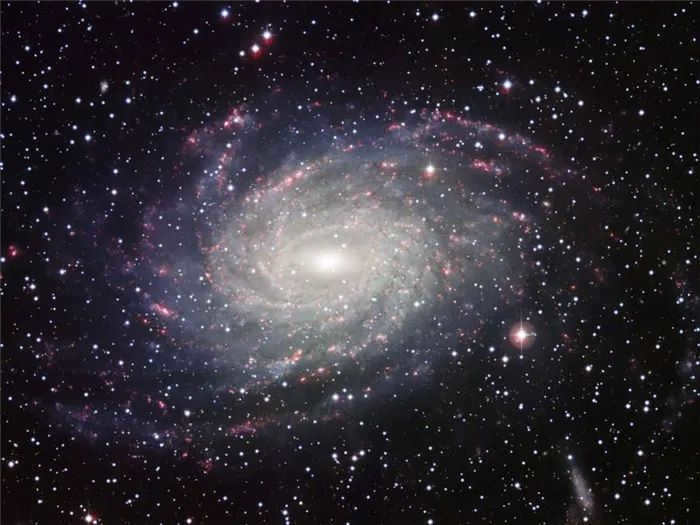

Displayed in the image is the NGC 6744 galaxy, which shares similarities with our very own Milky Way.
Distinct from a typical spiral, hyperbola instances feature a central core along with two branches. Our galaxy boasts two major arms and two minor ones, with our solar system situated in the Orion arm.
The Milky Way is not stationary; it rotates in space, carrying all objects within it. The solar system travels at a velocity of 828,000 km/h around the galactic center. However, due to the immense size of the galaxy, a single orbit takes approximately 230 million years.
The spiral arms accumulate a significant amount of dust and gas, providing the ideal conditions for the birth of new stars. These arms originate from the galactic disk, which spans around 1,000 light-years in length.
In the core of the Milky Way lies a dense accumulation of dust, stars, and gas. As a result, only a fraction of the overall population of stars within the galaxy is observable. The limited visibility is attributed to a compact nebula composed of gas and dust that obstructs the line of sight.
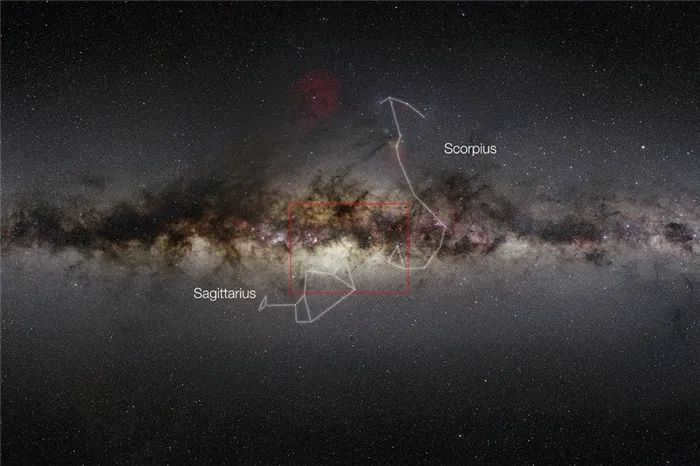

An infrared image showcases the expansive nature of the Milky Way
The center of the Milky Way houses an immensely massive supermassive black hole, surpassing the Sun’s mass by billions of times. Initially, it may have been considerably smaller, but regular consumption of dust and gas has facilitated its growth. Its voracity is astonishing, as it is even capable of engulfing stars. Naturally, it remains invisible to the naked eye, but its gravitational impact can be detected.
Encircling the galaxy is a halo of hot gas, harboring ancient stars and globular clusters. Spanning hundreds of thousands of light years, it contains a mere 2% of the stars found within the disk. Not to mention the presence of dark matter, which constitutes 90% of the galactic mass.
What is the shape of the Milky Way?
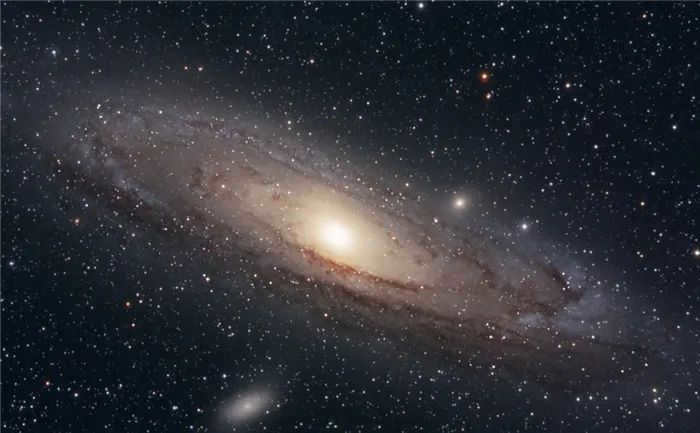
When studying the universe and observing galaxies, Edwin Hubble made an interesting observation – galaxies can exist in two different forms: spiral and elliptical. Spiral galaxies have a distinctive appearance, resembling a spinning disk with curved arms closely intertwined. Our very own Milky Way is classified as a spiral galaxy.
Before the advent of radio telescopes, scientists were unable to accurately measure the size and shape of galaxies. This was due to the presence of dust in space, which obstructed the path of light and caused significant errors in observations. However, the invention of radio telescopes allowed researchers to study the propagation of radio waves through space, providing a new way to gather data.
This revolutionary invention enabled scientists to precisely measure the distance and speed of most stars in the Milky Way. By combining the collected data, it became clear that all these stars were part of the spiral structure, occupying different arms of the galaxy.
Main characteristics of the Milky Way
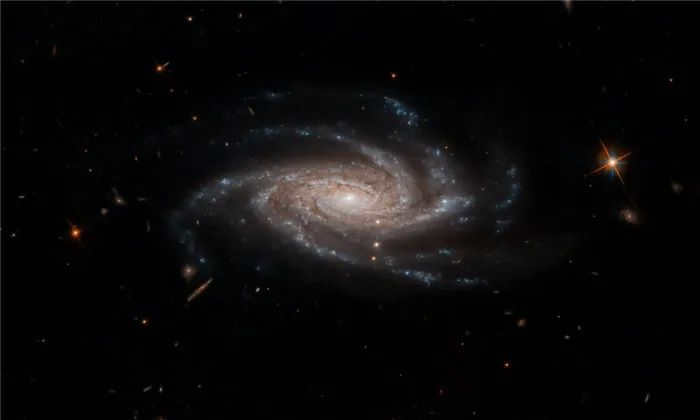
The galaxy derives its name from a fascinating ancient Greek myth. According to the myth, the titan Saturn devoured all the children that Rhea bore to him. Distraught by this, Rhea decided to save her last son, Zeus. She wrapped a stone in a blanket and presented it to Saturn, who unknowingly patted the stone and asked Rhea to feed it to the child to make him grow. Rhea poured milk on the stone, which miraculously repelled and scattered across the sky, forming the Milky Way. As Zeus grew up, he eventually overthrew the titan and ascended to become the ruler of the gods.
Interesting fact: Currently, the Milky Way is engulfing a dwarf galaxy located in the constellation Sagittarius.
Main features and attributes of the Milky Way
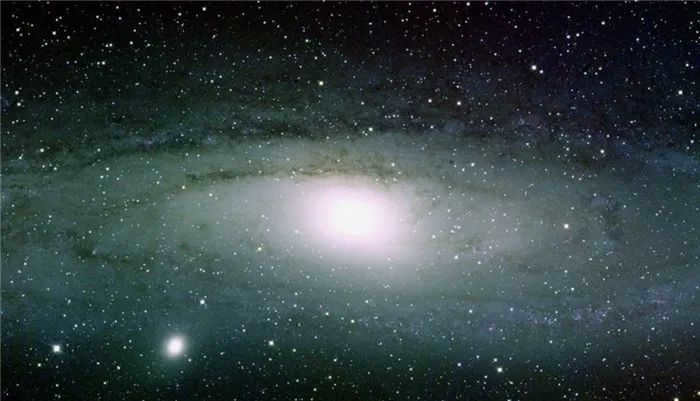
The Milky Way galaxy has been a subject of extensive research since it is the galaxy in which our solar system is located. Scientists have been studying its various aspects ever since the technology became available. As a result, a great deal of information about the Milky Way has been gathered, allowing us to determine its parameters with a high level of accuracy.
Here are some key characteristics of the Milky Way:
- It is classified as a spiral galaxy.
- It is part of the Local Group, which includes other neighboring clusters.
- The Milky Way has a diameter of approximately 100,000 light-years.
- It is estimated to contain between 200 and 400 billion stars.
- Our Sun is located about 27,000 light-years away from the center of the galaxy.
- The Milky Way galaxy has a rotation speed of 230 km/s around its central point.
- The combined mass of objects within the Milky Way is estimated to be one and a half trillion times that of our Sun.
It is important to acknowledge that these figures may have slight inaccuracies due to the vast scale of the galaxy.
Fascinating fact: The Sun, along with the planets, completes a full orbit around the galactic center every 235 million years.
What is the maximum duration a person can survive in outer space without the protection of a spacesuit?
Key Characteristics of the Milky Way
The Milky Way gets its name from a captivating legend. According to the myth, the mighty Saturn devoured all of the newborn children of Rhea, causing her great distress. Determined to save her sixth child, Jupiter, Rhea took a bold step.
She carefully swaddled the infant in a soft blanket and entrusted him to Cronus. However, Cronus believed the baby was too fragile and returned him to Rhea for nurturing. In a desperate attempt to nourish her child, Rhea struck the stone surface with her breast milk. Surprisingly, the milk ricocheted off the stone and scattered across the expanse of the sky, forming what we now know as the Milky Way.
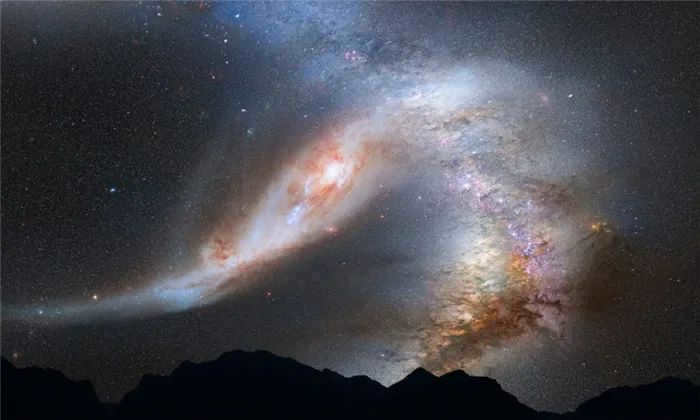
One notable aspect of the galaxy is its capacity to assimilate other entities: In close proximity, there are various groups of celestial bodies affiliated with distinct constellations. Once they enter the Galaxy’s realm of dominance, they become militarized.
Peruse the article on the Definition and Characteristics of a Galaxy
Key Features and Parameters of the Milky Way Galaxy
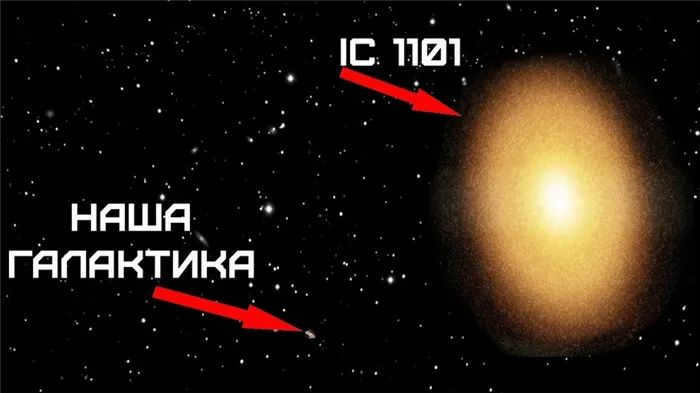

Some of the most significant characteristics are:
- It was the first galaxy to have its parameters studied with the advent of new technologies.
- The Milky Way is classified as a spiral galaxy.
- It is a member of the Local Group, along with other nearby celestial objects.
- The cosmic formation has a diameter of approximately 100,000 light-years and contains around 400 billion stars.
- The distance between the Milky Way and the Sun is 27,000 light years, and the Solar System rotates at a speed of 230 km/s.
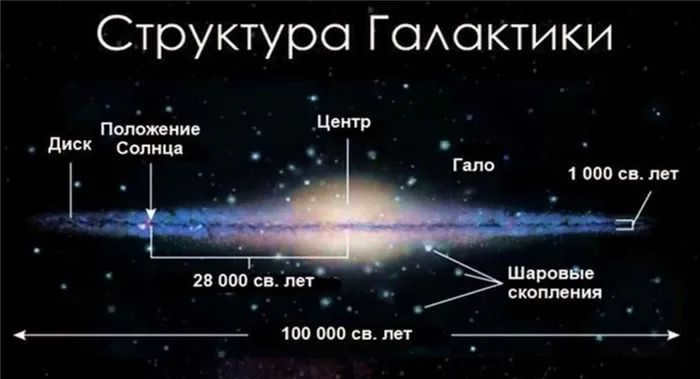
Formation and makeup of our galaxy, the Milky Way
At the heart of this celestial entity lies a central region known as the core, which is comprised of billions of stars. Researchers estimate that its span extends across thousands of parsecs.
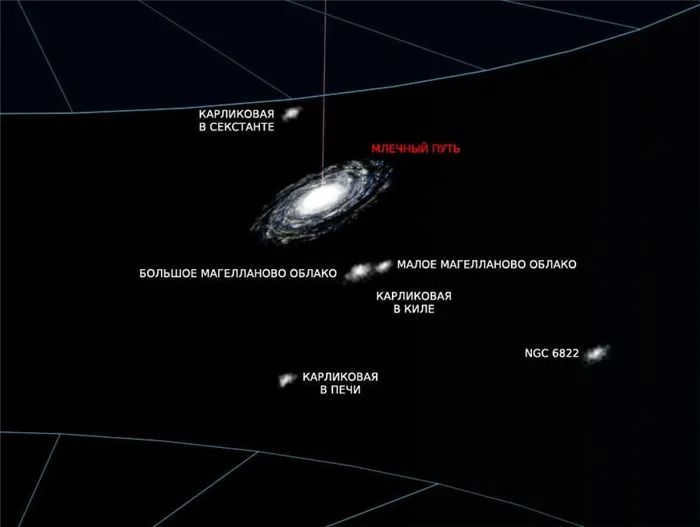
Our galaxy, the Milky Way, is encompassed by a dark halo consisting of dwarf galaxies and star clusters. These celestial bodies orbit the galaxy and are influenced by its presence.
Quantity of stars
The Milky Way is home to approximately 400 billion stars, including some that are highly active. Additionally, there are brown dwarfs within the galaxy, with their population ranging from 25 to 110 billion.
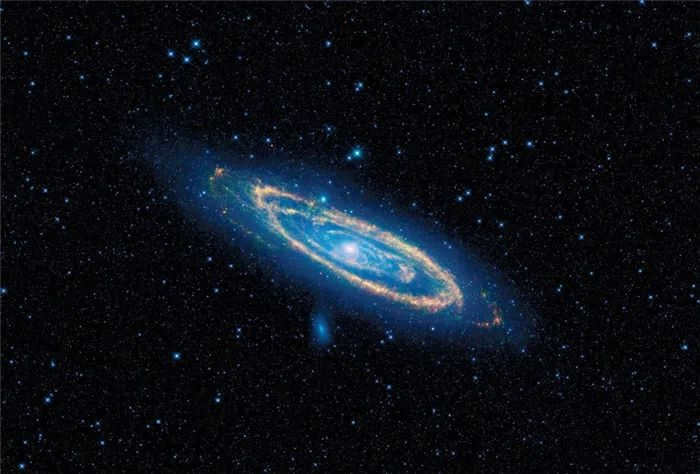
The objects’ brightness and size do not meet the criteria to be classified as ordinary stars.
Mass of the Galaxy
A significant portion of the Milky Way’s mass is composed of dark matter: in 2009, it was estimated to be 6*10^42 kg. However, recent discoveries in 2019 indicate that this value is significantly higher.
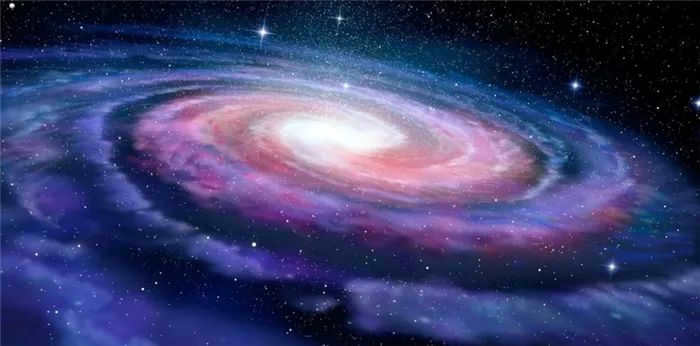
Galactic Disk
The galactic disk of our Milky Way spans a length of 100,000 light-years and experiences perpetual rotation.
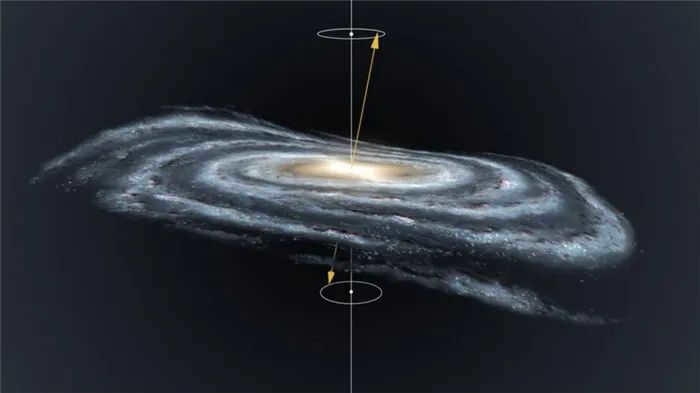
Objects located at the center are typically stationary, but can achieve velocities of up to 230 km/s when they are far away.
Nucleus
Around the core of the galaxy, there is a massive spherical structure spanning a distance of 27,000 light-years. This structure is thought to harbor a black hole of the Sagittarius A variety, as well as another black hole of moderate size.
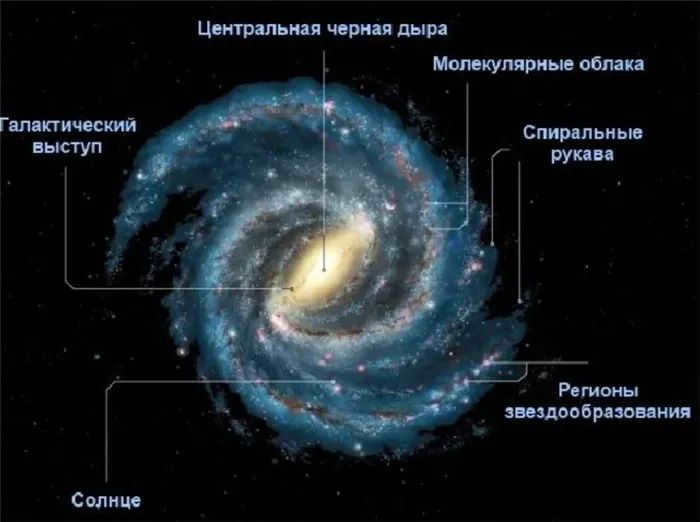
Both have a surrounding of stars that causes the core to emit light. In the center, there is also a cluster of red stars.
Arms of the Galaxy
The galaxy exhibits a spiral form with the arms positioned within the disk’s plane. Encircling the arms is a halo, referred to as a corona. The structure of the corona cannot be studied as the solar system is located within the disk.
Who was the second individual to venture into space following Gagarin?
Thanks to pioneering hydrogen research, it is possible to speculate about the configuration of the arms. They are likely interconnected.
Galactic halo
The spherical shape of the galactic halo envelops the Milky Way’s disk, with its size ranging from 5,000 to 10,000 light-years in different directions.
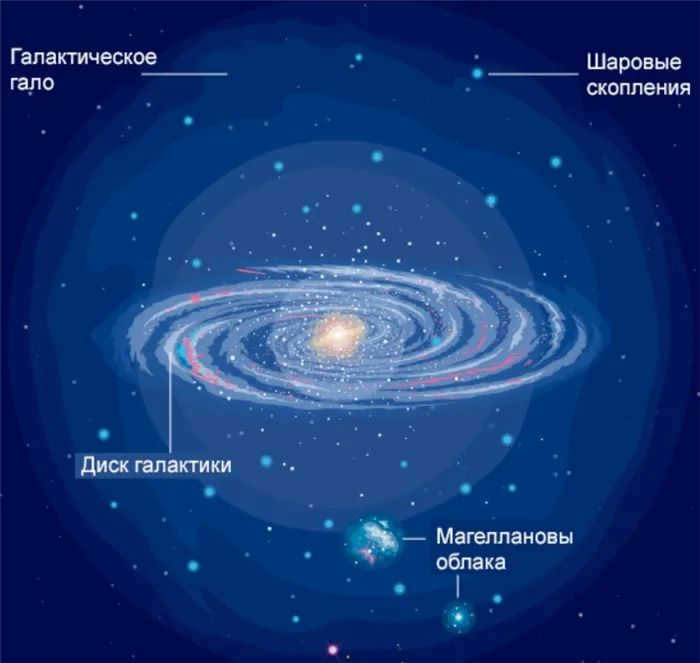
A halo refers to a group of stars that are significantly old.
Brightness
This galactic system possesses a brightness of 21 m, which corresponds to the brightness of 10 billion suns.
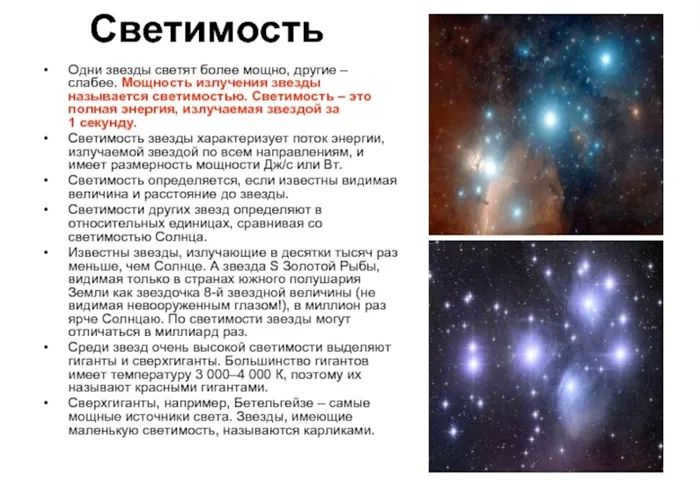
What is the age of our galaxy?
In this scenario, the relative abundance of iron to hydrogen was used to derive a reasonably precise estimation of the age of the celestial body. Based on this analysis, astronomers have deduced that the typical lifespan of stars within a dense disk is approximately 10 billion years. Consequently, the stars that we observe in our vicinity are indeed ancient stars. Therefore, it can be concluded that we inhabit an elder galaxy. While scientists have managed to determine the answer to this question, the age of the black hole within the Milky Way remains a mystery.
The Milky Way doesn’t simply rotate, but rather each celestial object within the Universe moves along its own designated orbit. It has been estimated that our cosmic abode will eventually collide with the Andromeda Nebula in approximately 4 billion years. These two entities are gradually approaching each other at a speed of 120 kilometers per second. Interestingly, from the perspective of an observer within our galaxy, Earth would be situated within the constellation of the Lesser Dog.
The repercussions of this collision will unfold gradually, and it remains unknown whether inhabitants of Earth will be able to perceive these effects. A direct impact of this astronomical event on the Sun is highly improbable.
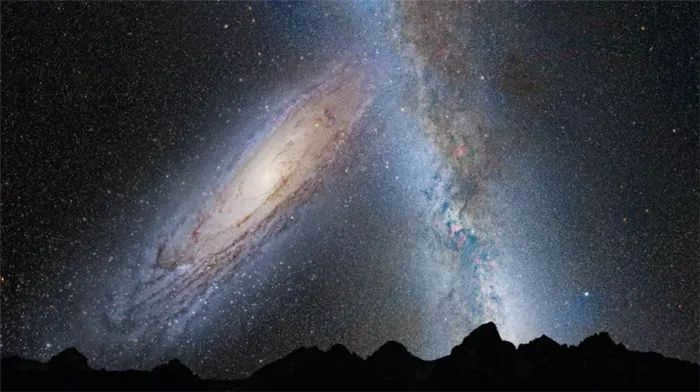
It is conceivable that the newly formed galaxy could completely eject the Solar System, transforming it into an intergalactic entity. This transformation, however, would not pose any detrimental effects on the Solar System. From the perspective of an Earth observer, the most significant change would be witnessed in the night sky, as it would no longer exhibit the same level of beauty. The constellations of the Milky Way would also undergo alterations. Nevertheless, it is important to note that these changes would not have any repercussions on life as we know it, as the Earth’s atmosphere provides ample protection against cosmic radiation. The evolution of the Sun, on the other hand, holds far greater significance for the sustenance of life.
Evolution and the future of our galaxy
The galaxy we call home, the Milky Way, is considered to be quite ancient, with its oldest star estimated to be around 13.7 billion years old. Remarkably, this makes it only about 100 million years younger than the Universe itself. During this immense span of time, galaxies like ours underwent rapid evolution, giving rise to the creation of heavy elements such as carbon, oxygen, and many others. This process was crucial, as without it, the stars within the Milky Way would have grown to such enormous sizes that they would have burned out within just a few million years.
Simultaneously, the Milky Way has been continuously absorbing matter into its halo. This ongoing process still occurs to this day. The gas clouds that fall into the galactic disk serve as the essential building blocks for the formation of new stars. Furthermore, in its early stages, our galaxy even absorbed smaller, neighboring galaxies, further contributing to its growth and complexity.
The Milky Way has only experienced half of its lifespan: the stars are still in their youth, but the available gas for star formation is depleting. Currently, there is no evidence indicating that the Milky Way is transitioning into a red-sequence galaxy.
At present, the Milky Way is in the process of assimilating the Large Magellanic Cloud and the Small Magellanic Cloud, which are converging towards the southern pole of the cluster. One thing that is certain is that the Milky Way will eventually collide with Andromeda, resulting in a merger.
The collision will not cause the Milky Way to vanish, nor will it lead to the destruction of the planets within it. Instead, they will simply become part of a new cluster. However, even the most imaginative science fiction writers would hesitate to speculate on such a distant timescale, as it surpasses the lifespan of life on this planet.
Mythology
Ancient legends depict the development of the cosmos in various manners.
Armenian
Vahagn, the divine ancestor of the Armenians, surreptitiously took straw from the progenitor of the Assyrians and concealed himself in the celestial realms. As he traversed upon it, the straw descended and fashioned a celestial pathway. To this day, our galaxy is referred to as “the path of straw” in Armenian. Analogous tales of scattered straw can be found in the mythologies of Arabic, Hebrew, Persian, and Turkish cultures.
Hungarian
Legend has it that Attila descended to the Earth by following the path of the Milky Way when he sensed imminent danger. The sound of hoof beats created sparks as he came down.
Greek
In Greek mythology, it is said that while Hera was nursing Heracles, she accidentally spilled some of his mother’s milk into the sky. Hera later discovered that she was not nursing her own son, but the illegitimate child of Zeus and a mortal woman. Out of anger, she discarded the child, and the spilled milk became the inspiration for the name of our galaxy.
India
The people of India had a belief that the Milky Way is formed from the milk of a red cow that traverses the sky every evening. The Rigveda mentions the holy path of Aryaman. The Bhagavata-purana describes the celestial dolphin’s belly.
Mythology of the East
The Vietnamese, Chinese, and Japanese view the galaxy as a flowing silver river. The Chinese also refer to this cluster of stars as the “yellow river”.
Indigenous Peoples of North America: Legends and Myths
The mythology of the indigenous peoples of North America is rich and diverse. Among the Eskimos, there is a legendary tale of a girl who scattered ashes across the sky, creating a path of light to guide people at night. This story speaks to the resourcefulness and ingenuity of the Eskimo people.
The Cherokee, on the other hand, have a different myth about the creation of the Milky Way. According to their legend, the Milky Way was formed when one hunter stole another hunter’s wife. In the chaos that ensued, the stolen wife’s dog ate cornmeal and scattered it across the sky, creating the beautiful starry expanse we see today. Interestingly, similar stories are found among tribes living in the Kalahari Desert, showing the universal nature of myth and storytelling.
While the Milky Way holds a special place in the mythology of these indigenous peoples, it is also a subject of great scientific interest. As one of the most studied galaxies, it continues to captivate astronomers and researchers. With advancements in space technology, we are able to unravel the mysteries and secrets of our cosmic home, bringing us closer to understanding the universe we inhabit.
1 comment/ 702
There are over 100 billion stars in our Galaxy. The diameter of the Galaxy’s disk is approximately 30,000 parsecs (100,000 light-years), and it has a thickness of about 1,000 light-years.
The stars in the disk follow circular orbits around the Galactic center, similar to how planets in our solar system orbit around the Sun. When viewed from the north pole of the Galaxy (located in the constellation Veronica’s Hair), the rotation of the Galaxy is clockwise. The speed of rotation varies at different distances from the center, decreasing as you move farther away.
The density of stars increases as you move closer to the center of the Galaxy. If we were to live on a planet near a star in the central region of the Galaxy, we would see numerous stars in the sky that shine as brightly as the Moon.
Despite being situated on the outskirts of the Galaxy, approximately 26 thousand light years (8.5 thousand parsecs) away from its center, the Sun is positioned near the galactic plane. Specifically, it can be found in the Orion arm, which is connected to two larger arms known as the inner arm of Sagittarius and the outer arm of Perseus.
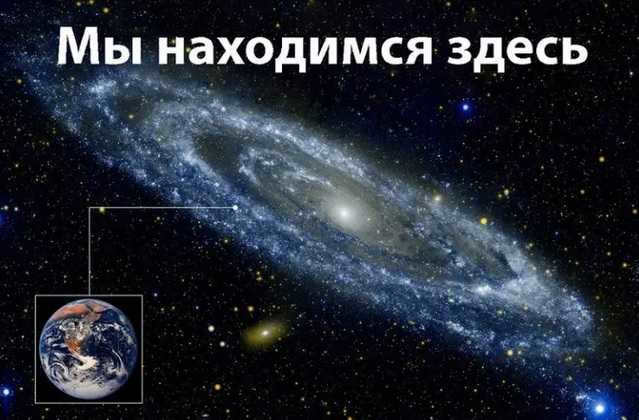
How humanity discovered the secrets of the Galaxy
Galileo Galilei, an Italian mathematician, physicist, and astronomer, played a pivotal role in advancing our understanding of the stars. In the early 17th century, he constructed a revolutionary telescope equipped with a convex lens and a concave eyepiece. This groundbreaking device provided threefold magnification. As Galileo continued to refine his telescope, he achieved an impressive 32-fold magnification. Notably, Galileo also coined the term “telescope” for scientific use.
Through observations made with his telescope, Galileo made remarkable discoveries about the Moon, revealing its rugged terrain and pockmarked surface. He also unraveled the mysteries of lunar phenomena such as ashen light and libration. Furthermore, Galileo’s observations led to the identification of Jupiter’s satellites, expanding our knowledge of celestial bodies beyond our own planet.
He also demonstrated that the Milky Way consists of a multitude of stars. However, Galileo’s observations did not provide clarification on the origin of our galaxy and the most crucial question: whether they resemble the Sun.
In the 18th century, the English scientist W. Herschel initiated the task of counting stars in the nocturnal sky. He made a remarkable discovery of a vast ring, named the “galactic equator,” that divides the visible portion of the celestial sphere into two equal sections. Within this region, the number of stars reached its maximum. It was also revealed that the number of celestial bodies increases as a particular section of the sky approaches the “galactic equator.” This evidence served to establish that all cosmic entities accessible to the observer constitute a single, extensive system, which is compressed in the equatorial zone.
What is our understanding of the Milky Way galaxy?
Let’s begin by examining the mass of the Milky Way. The Milky Way is of such immense size that it warrants its own unit of measurement: the mass of the Sun. When considering the collective weight of all the stars, dust, gas, and substantial quantities of dark matter that encompass our galaxy in a halo, the total comes to approximately 3 trillion solar masses, based on the latest estimates available at the time of writing. Previous calculations have estimated the figure to be in excess of 1 trillion solar masses. Dark matter represents around 90% of this mass, signifying that it is composed of material that is not affected by its own gravitational pull.
Naturally, the Milky Way is not only composed of dark matter – it also contains a significant amount of dust, gas, and stars that fill the galactic space. Scientists estimate that there are approximately 200 to 400 billion stars in the Milky Way, although only a small fraction of these stars, around 5000 to 8000, can be seen with the naked eye. Furthermore, at any given time from Earth, we can only observe about 2500 of these stars.
The Milky Way is made up of the following components:
1 – Stars, which can exist as single stars, multiple stars, or in globular and scattered clusters.
2 – Interstellar gas, which includes atomic and molecular hydrogen, as well as other gases and complex chemical compounds, including organic substances.
3 – Dust, which consists of particles with sizes ranging from 10 -5 to 10 -4 cm. Dust particles are often found in clouds along with gas.
4 – Cosmic rays, which are streams of high-energy particles. These cosmic rays are controlled and influenced by the magnetic field of the Milky Way.
The Galaxy can be divided into two main parts: the disk and the halo. The halo consists of globular clusters, subdwarf stars with high velocities, and a low abundance of elements heavier than helium. Additionally, it contains special types of variable stars and is believed to contain the oldest structures in the Galaxy, with an estimated age of at least 10 billion years. On the other hand, the disk encompasses the remaining stars, scattered clusters, and interstellar gas and dust clouds. This initial classification has been further refined to include intermediate, younger, and older components within the disk and halo. The Sun is classified as part of the older component of the disk.
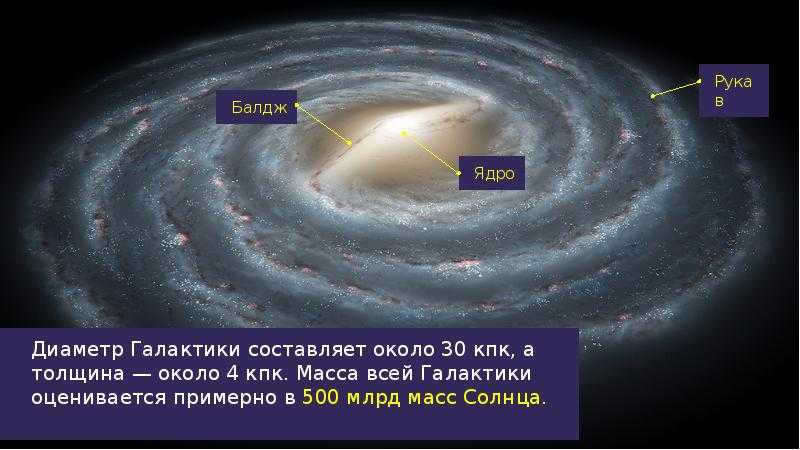
The composition of our galaxy
The Milky Way, our galaxy, is a spiral disk containing four intertwining arms and a dense central bulge.
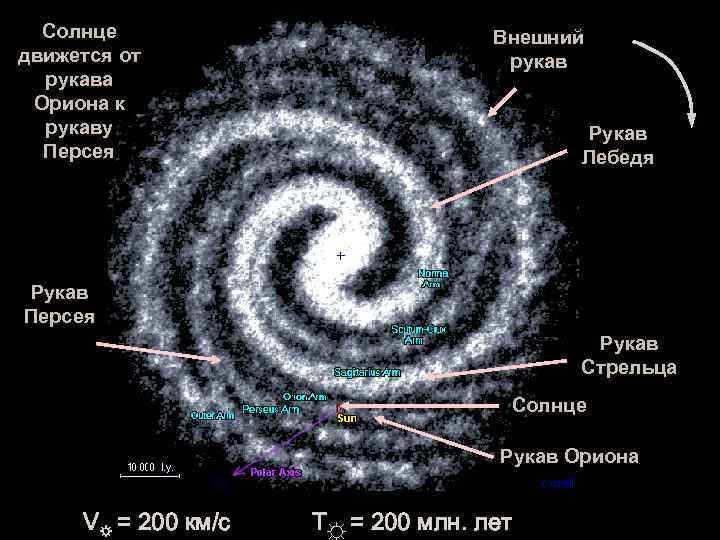
The thickness of the Milky Way’s disk spans approximately 500 sv. years, which is the time it would take for light to travel across it. The arms of the galaxy have a radius of around 50,000 sv. years. The central region of the Milky Way, which is denser, has a diameter of 3,000 sv. years and is encompassed by a group of approximately 200 globular star clusters, also known as a halo.
The disk of our galaxy rotates at a much faster rate than the halo, and this rotation occurs at different speeds. As it approaches the black hole, the rotation speed decreases until it reaches zero. However, at a distance of about 2 thousand light-years, the rotation speed increases to 240 km/s. It then experiences a slight decrease before returning to the aforementioned speed and maintaining it.
Close to the disk, there are youthful stars (these objects are no older than a couple of billion years). Juvenile celestial bodies create a level constituent, with numerous entities possessing elevated temperatures. Adjacent to the disk plane, the bulk of gas exists in the form of gaseous clouds. Miniature clouds possess a diameter of approximately one parsec. Colossal gaseous entities are positioned throughout the vast expanse for thousands of light years.
The dark stripe that we observe at night along the Milky Way (and in images of other galaxies) suggests that the space between stars in our Galaxy is filled with massive clouds of gas and dust that absorb visible light but allow radio waves and infrared radiation to pass through. It was through the use of radio astronomy and infrared satellite observations that scientists were able to determine the spiral structure of our galaxy, with four distinct arms, and estimate that the Sun is located approximately 25,000 light-years away from the central region. Over the course of its existence, the Sun has completed approximately 25 revolutions around the center of the Milky Way, taking about 200 million years for each revolution. In a metaphorical sense, we can say that the Sun is 25 “galactic years” old!
A source emitting an extraordinary amount of energy has been detected in the central region of our galaxy. Despite its relatively small size (comparable to the solar system), it possesses a mass one million times greater than that of the Sun and emits radiation that is 100 million times more intense across a wide spectrum. Initially thought to be a result of a burst of star formation involving “young” stars, the current prevailing hypothesis points towards the presence of a black hole at the core of the Milky Way. The center of this core can be found in the constellation of Sagittarius.
Ever since the Big Bang and the birth of the universe, everything within it has been in perpetual motion. In the past, scientists held the belief that the Milky Way encompassed the entire cosmos, with nothing existing beyond its boundaries.
Thanks to the advancements in modern telescopes, we now have a glimpse into what lies beyond our galaxy. The Milky Way’s “neighbors” are the celestial objects that make up the Local Group, with the largest being the Andromeda Nebula. Slightly further away is the Triangle Nebula, both of which are surrounded by satellite dwarf clusters.
Within the Local Group, there are also elliptical and irregular galaxies, all of which are situated within specific constellations.
The Encounter of the Milky Way and Andromeda Galaxies
The Milky Way Galaxy not only spins on its axis, but also follows a predetermined path through the vastness of space. According to scientific calculations, in approximately 4 billion years, our galactic home will experience a dramatic collision with the Andromeda Nebula. Both celestial bodies are currently approaching each other at a staggering speed of 120 kilometers per second. Interestingly, if one were to observe this event from the Andromeda Galaxy, they would find Earth located within the constellation of Canis Minor, also known as the Lesser Dog.
The effects of this monumental collision will unfold gradually over time, and it remains uncertain whether Earth-based observers will be able to witness its direct consequences. The likelihood of any significant impact on the Sun resulting from this cosmic event is considered to be extremely low.
